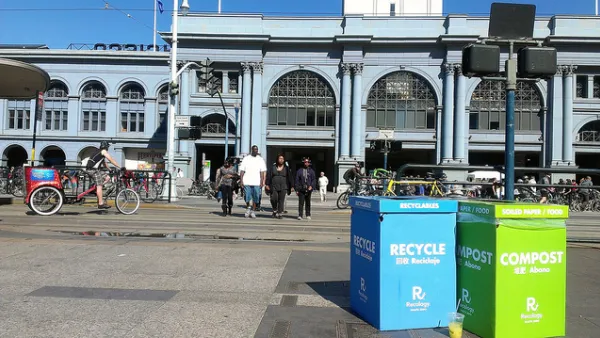Air travel is a notoriously wasteful mode. But one airport is taking huge leaps towards sustainability. Julie Rose reports on Charlotte Douglas International's comprehensive recycling and composting program.
Airports generate a lot of waste. Everything is disposable, clothes are scrapped to meet weight requirements, travelers eat on the run and discard half their food. But in North Carolina, at one of the busiest airports in the U.S., they are serious about recycling, reducing and reusing. Everyday twenty-five tons of trash cascade onto a conveyor belt where it is hand-sorted by a dozen employees. Recyclables are bundled and sold. Discarded clothing is laundered and donated. Food waste is composted on site with the help of a couple (million) critters. All the organic matter is transferred into a series of 50-foot long beds where 1.9 million worms get to work producing fertilizer for airport landscaping.
In four short months, the Charlotte airport has reduced the amount of trash going to the landfill by 70%. Turning trash into worm poop might seem like funny business for an airport, as Rose points out, "Charlotte officials sure did as they debated the $1.2 million it cost to launch the program. But they're not laughing now: The airport expects to be making money off its trash in five years."
FULL STORY: One Airport's Trash Is 2 Million Worms' Treasure

National Parks Layoffs Will Cause Communities to Lose Billions
Thousands of essential park workers were laid off this week, just before the busy spring break season.

Retro-silient?: America’s First “Eco-burb,” The Woodlands Turns 50
A master-planned community north of Houston offers lessons on green infrastructure and resilient design, but falls short of its founder’s lofty affordability and walkability goals.

Delivering for America Plan Will Downgrade Mail Service in at Least 49.5 Percent of Zip Codes
Republican and Democrat lawmakers criticize the plan for its disproportionate negative impact on rural communities.

Test News Post 1
This is a summary

Test News Headline 46
Test for the image on the front page.

Balancing Bombs and Butterflies: How the National Guard Protects a Rare Species
The National Guard at Fort Indiantown Gap uses GIS technology and land management strategies to balance military training with conservation efforts, ensuring the survival of the rare eastern regal fritillary butterfly.
Urban Design for Planners 1: Software Tools
This six-course series explores essential urban design concepts using open source software and equips planners with the tools they need to participate fully in the urban design process.
Planning for Universal Design
Learn the tools for implementing Universal Design in planning regulations.
EMC Planning Group, Inc.
Planetizen
Planetizen
Mpact (formerly Rail~Volution)
Great Falls Development Authority, Inc.
HUDs Office of Policy Development and Research
NYU Wagner Graduate School of Public Service




























